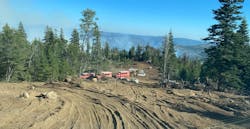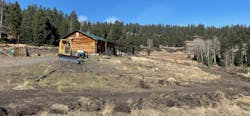California has experienced destructive wildfires for many years. However, things started changing during the 2015 fire season, particularly in Northern California. On Sept. 12, around 1 p.m., the Valley Fire sparked near the Cobb community in Lake County. By 6 p.m., the fire already was more than 10,000 acres, and by Sept. 15, the fire was more than 50,000 acres and destroyed much of the communities of Cobb, Middletown and Whispering Pines and portions of Hidden Valley Lake. Based on the number of structures that burned, this fire became at that time the third most destructive fire in California’s history.
The Valley Fire was just the beginning. Multiple life-changing wildfires ravaged Northern California during the coming summers.
The new normal
At the time of the Valley Fire, most members of the fire service hadn’t seen a large wildfire proliferate through timber and destroy everything in its path. Now, massive wildfires, particularly in Northern California, unfortunately are expected.
Generally, there are some commonalities in the initial stages of these destructive fires. Typically, California is experiencing heat and windy weather conditions. Vegetation is drought-stricken, contributing to poor forest health, including overgrowth and beetle-killed trees. Combining these factors with the topography of California leads to nightmarish fire seasons.
Risk assessment
A risk assessment drives continuous evaluation of the potential success of tactics and strategies for achieving the control objectives of a wildfire. For every fire, we complete a conscious or subconscious risk assessment. This assessment process combines the evaluation of weather, fuel, fire history, topography, firefighter and equipment availability and capabilities, and the values at risk. Depending on the outputs of each of these factors, we can align tactics and strategies and identify achievable control objectives.
As firefighters, we understand that there is risk in our job; however, we often can reduce the risk by implementing safety measures. An example of an adjustment to reduce risk: Crews implement direct tactics up a steep hill to stop a fire in its current footprint. However, the mountain has boulders that keep getting dislodged and rolling toward other firefighters. Firefighters might abandon the direct attack and build a fireline up an adjacent ridge, where indirect tactics have a high probability of success while limiting the exposure of the boulders to firefighters.
The risk assessment is a critical process that must be continuously reevaluated as conditions and resources rapidly change.
Values at risk
The values-at-risk analysis contributes significantly to the aggressiveness of a plan.
In California, most fires threaten human lives. Because saving lives is our top priority, tactics and strategy become significantly more aggressive, and the risk increases.Beyond life, we evaluate property threats. Although structures can be rebuilt, our second priority is to save as much property as possible. When prioritizing property, firefighters generally prioritize essential infrastructure in a community. Top priorities include schools, grocery stores, supply stores, places of worship, libraries, police/fire stations and other critical community structures. We increase resiliency after the fire if we save vital infrastructure.
An additional consideration is the environment. Environmental factors are noteworthy and highly considered when choosing tactics, strategies and control objectives. Archeological sites, critical timber stands, historical landmarks and watersheds are some of the factors that drive overall goals.
Probability of success
The probability of success is a crucial input when identifying control objectives. Although a control line can be placed in almost any location, we must ask ourselves, “What is the probability of successfully stopping the fire at this location?” If the probability of success is low, we might look to another location that has a potentially high likelihood. However, depending on the values-at-risk assessment, locations might be selected even when the probability is low. These situations typically are limited to times when a high value is at risk, including lives, essential property and a high-value environmental threat. We often have a low probability of success, but because of the value that’s threatened, we implement high-risk tactics and strategies to protect the values. As in all firefights, we give our best in these situations and often win.
Containment box
Once firefighters complete their risk assessment of the wildfire, which includes the values-at-risk analysis, they can identify the control objectives of the wildfire.
Control objectives are known commonly as the containment box. Creating this “box” allows the firefighting force to implement tactics and strategies to keep the fire within the identified box. Put another way, the containment box is a strategic “line in the sand,” where firefighters identify the optimal location to stop fire spread while protecting the values at risk
Various types of roads and geographical features generally are selected as containment objectives. For example, the control objectives might be to keep the fire north of a community, south of a freeway, east of a river and west of a railway.
Control objectives must be identified and communicated throughout a wildfire. The control objectives might be simple in the early stages of the fire, because most fire objectives can be met with an aggressive fire attack through ground
and air resources. An aggressive assault on most wildfires produces positive results that keep the fire small and limit its transition into an extended attack fire. However, there are times when a wildfire’s growth exceeds initial fire attack capabilities, and the control objectives must change and adapt based on the risk assessment.
Progress now, progress ahead
The California fire service should be applauded for how it has adapted and made great strides with prevention, preparedness, communication with the public, and overall strategy and tactics to combat wildfires. Identifying the values at risk, completing a risk assessment, quantifying the probability of success and implementing control objectives (the containment box) that protect the highest values comprise a successful process that wildland fighters use during initial attacks and extended wildfires.
Knowing firsthand the challenges of a rapidly growing fire, saving civilian lives and our own often is all that we can do during these massive growth periods. However, we are better prepared than ever, and I’m confident that modern-day and future fire service leaders will continue to grow and provide increased protection to those who we serve.
About the Author

Chad Costa
Chad Costa is the assistant chief for the Petaluma, CA, Fire Department. With more than 26 years of fire service experience, he has worked in various organizations, including CAL FIRE, rural and semi-rural districts, and a city. As a battalion chief, Costa was the technology and communications battalion chief. He is now a rostered operations branch director for CalFire Team 1 and an alternate operations section chief trainee on California Interagency Team 5. Costa is an accredited Chief Fire Officer through the Center for Public Safety Excellence and has a bachelor’s degree in emergency services management, a master’s degree in fire service leadership, and a certificate in homeland security. Costa has also completed the Executive Chief Officer Program at the National Fire Academy. Costa is a member of the Firehouse Editorial Advisory Board.

